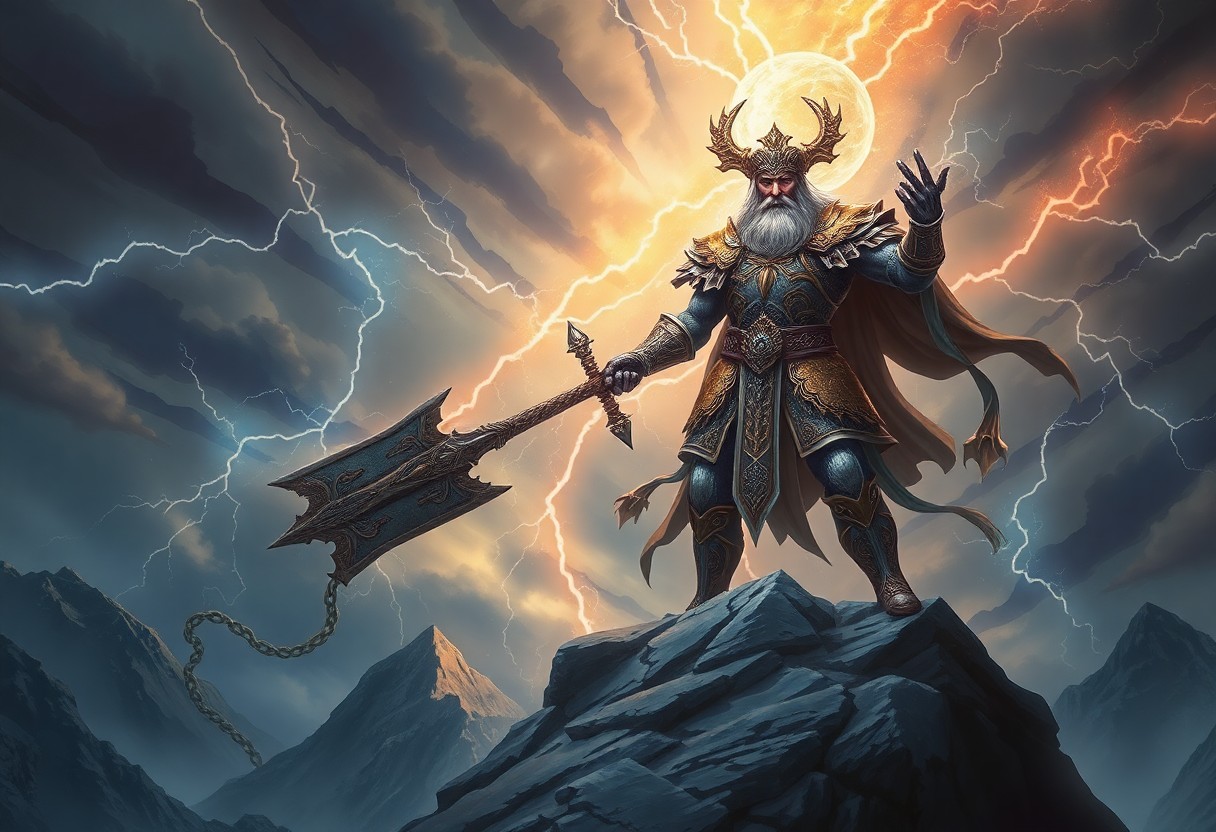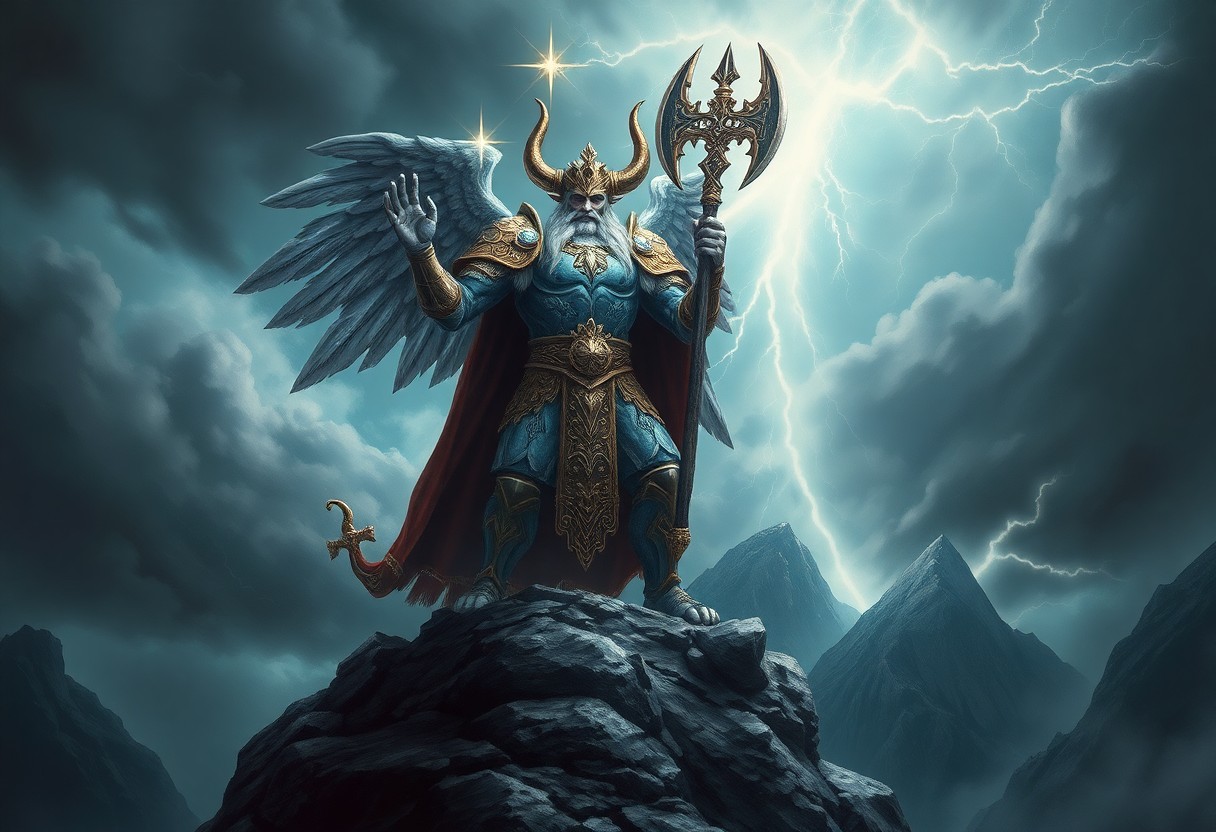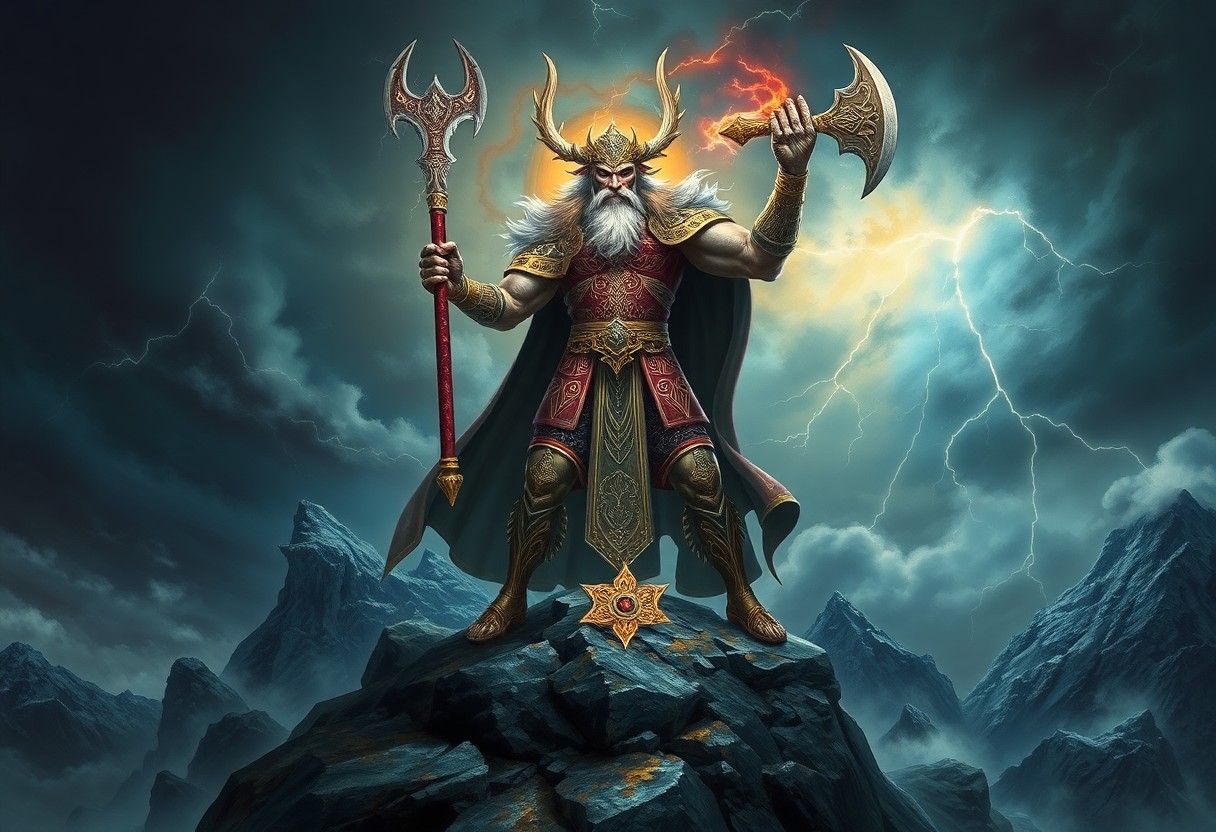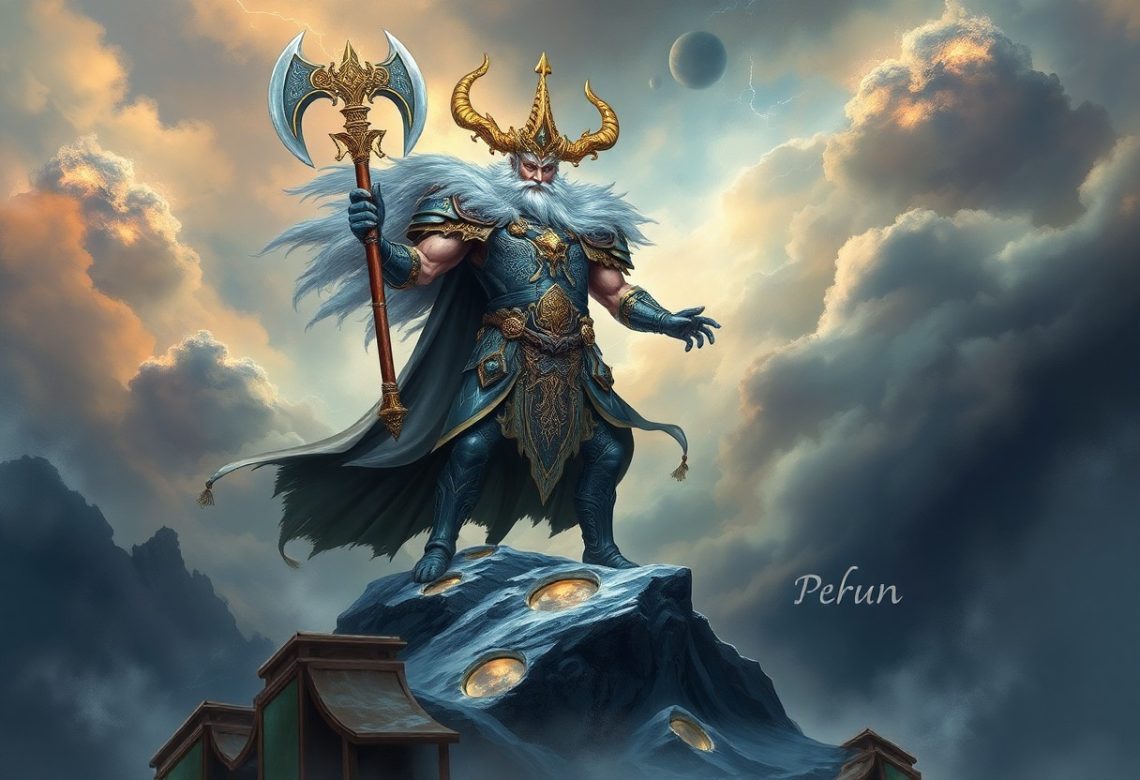Perun is a significant figure in Slavic mythology, revered as the thunderous war god of Kyiv Rus. As you explore the rich tapestry of ancient Slavic beliefs, you’ll find that Perun symbolizes strength, warfare, and protection, embodying the essence of a warrior’s spirit. Understanding his role in the lives of the people offers you valuable insights into their customs, rituals, and the cultural importance of deities in shaping societal values. Delve deeper into the myths and legends surrounding Perun and uncover how this powerful god influenced the past.
Origins of Perun
Before delving into the various tales of Perun, it is necessary to understand his origins. You can trace this thunderous deity back to ancient Slavic mythology, where he served as the protector of the people and the warrior god associated with storms and warfare. Perun is often depicted wielding a mighty axe, representing not just his martial prowess, but also his role as a bringer of rain, vital for agricultural prosperity. Your exploration of his evolution will reveal how Perun became a central figure in the pantheon of Kyiv Rus.
Historical Context
By examining the historical context surrounding Perun, you will find that his worship flourished during the late 9th and 10th centuries. As the Kyiv Rus emerged as a powerful state, the integration of various pagan deities into their cultural identity played a significant role in unifying different tribes and solidifying central authority. You’ll notice that as the influence of Christianity began to spread, many Slavic gods, including Perun, were adapted or overshadowed, yet they remained enduring symbols of heritage and resilience.
Cultural Significance
Cultural significance of Perun encompasses not only his role as a warrior god but also his influence on the everyday lives of the people. You should consider how his image permeated folklore, rituals, and even the arts in Kyiv Rus, creating a lasting legacy that resonates even today. From agricultural ceremonies to warrior traditions, Perun’s presence manifested in various social aspects, reinforcing community bonds and cultural identity. You will find that even in modern interpretations, Perun continues to symbolize strength, valor, and the resilience of the Slavic spirit.
It is fascinating to observe how Perun’s cultural significance extended beyond mere mythology. You may discover that festivals held in his honor included offerings and rituals aimed at ensuring a successful harvest and victory in battle. His image traditionally embodied the natural forces that the people revered and respected, reflecting their deep connection to the environment. Moreover, the integration of Perun into various artistic expressions highlighted the importance of shared cultural narratives, allowing you to appreciate how the essence of this thunderous god still resonates throughout Slavic traditions today.
Attributes and Symbols
The attributes and symbols associated with Perun reflect his powerful role within the pantheon of Kyiv Rus. As the thunderous war god, he was often depicted with a sword and an axe, symbolizing his martial prowess and authority. Additionally, oak trees are sacred to him, representing strength and stability, while his associations with the sky and storms underline his dominion over natural forces.
Iconography of Perun
Any portrayal of Perun is filled with vivid imagery that emphasizes his importance in Slavic mythology. Typically, you might encounter him depicted as a robust warrior brandishing thunderbolts or wielding weapons. Often, he is shown alongside animals like horses and eagles, embodying his fierce, dynamic spirit and connection to the heavens.
Associations with Thunder and War
Associations between Perun, thunder, and war reflect the chaos of battle and the majesty of storms. You see this connection reinforced in the storms he unleashes during conflicts, symbolizing his wrath and power. His thunderous presence on the battlefield inspires warriors, who believe he fights alongside them, amplifying their courage against their foes.
Attributes such as strength, valor, and dominance are crucial to understanding Perun’s role as a god of thunder and war. You can see how his imagery as a warrior commands respect, instilling both fear and awe. When engaging with this aspect of his mythology, think of the ways in which those attributes empower you, reminding you of your own capacity for strength in adversity and your ability to overcome challenges.

Worship and Rituals
Some aspects of worship dedicated to Perun involved offerings and rituals that emphasized the connection between the divine and the earthly. You would find communities coming together during significant life events, such as harvests or battles, to honor him, reflecting a deep respect for his power and guidance.
Sites of Worship in Kyiv Rus
The primary sites of worship for Perun included sacred groves and high hills, where you might envision gatherings for ceremonies. These locations served as natural sanctuaries, believed to be closer to the heavens and thus ideal for invoking the Thunder God’s presence during prayer and sacrifice.
Ceremonial Practices
With every ritual performed in honor of Perun, you would witness the deep commitment of the Kyiv Rus people, who participated in vibrant ceremonies characterized by feasting, singing, and offerings. The sanctity of the rituals fostered a collective identity that fortified their bond with each other and their deity.
But these practices were not merely for show; each element was deeply symbolic. Sacrifices often included animals, which were seen as vital offerings to appease Perun’s wrath and gain his favor, ensuring prosperous seasons ahead. The communal nature of these celebrations allowed you to participate in sacred traditions that reinforced social bonds, while prayers and invocations urged for protection in times of war. Through these observances, the essence of Perun lived on in the hearts of the people, shaping their daily lives and beliefs.

Perun in Mythology
Unlike many other deities within the Slavic pantheon, Perun stands out as the formidable god of thunder, war, and fertility. Revered in Kyiv Rus mythology, he is portrayed as a powerful figure wielding a mighty axe or hammer, symbolizing the thunderous storms he controlled. You may discover that Perun’s association with natural phenomena reflects the spiritual connection the ancient Slavs had with their environment, lending profound significance to his character in your understanding of Slavic lore.
Legends and Stories
Below, you will find fascinating tales illustrating Perun’s might and virtues. One enduring legend recounts how he battled Veles, the god of the underworld, to retrieve stolen cattle and protect the realm. Such stories not only highlight his heroism but also emphasize the ongoing conflict between good and evil, resonating with the moral values cherished by the medieval Slavs. These narratives serve to enrich your appreciation of Perun’s role within their cultural framework.
Connections to Other Deities
Any exploration of Perun’s significance should include his relationships with other deities in Slavic mythology. He is often contrasted with Veles, the cunning god associated with the earth and waters, symbolizing the duality of chaos and order in nature. The dynamic between these two gods illustrates the constant struggle between opposing forces in the Slavic worldview, reminding you of the intricate balance that existed in these ancient beliefs.
In fact, this duality further connects Perun to other natural elements and deities within the Slavic pantheon. Attributes of storms, agriculture, and war observed in his mythology resonate with the themes of balance displayed in stories of other gods and goddesses. You may find that this interplay of relationships forms a tapestry of divine influence, showcasing how indispensable Perun is in understanding the complexities within Slavic spirituality and culture.
Influence on Slavic Culture
To understand Perun’s significance, you must recognize his pervasive influence on Slavic culture. As a deity of war and thunder, he played a vital role in shaping the values, beliefs, and social structure of the ancient Slavic people. His representation as the protector of the community highlights the importance of bravery and strength in their society, aspects that still resonate in modern Slavic folklore and traditions.
Perun in Literature and Art
Between ancient texts and folklore, Perun is often depicted as a symbol of heroism and divine justice. His presence in epics and poetry reflects the reverence Slavic cultures had for him, portraying not only his martial prowess but also his role as a guardian of order and moral integrity. This artistic representation has contributed to the rich tapestry of Slavic mythology, inspiring countless stories and works of art that continue to celebrate his legacy.
Modern Reinterpretations
Against the backdrop of contemporary culture, Perun’s character has been reimagined in various forms, ranging from literature to multimedia. His attributes may be infused into modern storytelling, reflecting current themes of strength and moral guidance, thus bridging ancient beliefs with today’s societal values.
Culture enthusiasts often explore how the reinterpretation of Perun manifests in modern storytelling and art. You may find his image in graphic novels, video games, and films, where he is portrayed not only as a warrior but also as a multifaceted character grappling with the challenges of leadership and responsibility. These modern adaptations allow you to connect with Slavic heritage while appreciating the timeless qualities that Perun embodies, ensuring that his spirit continues to resonate across generations.

The Legacy of Perun
Now, the legacy of Perun lives on, manifesting in the culture, literature, and art of the region. His image as a powerful warrior god resonates in various forms, inspiring people to embrace their roots and cultural heritage. You can see the remnants of his influence in modern Ukrainian folklore, music, and religious practices, where his attributes symbolize strength and resilience. Perun’s legacy serves as a reminder of the ancient ties that connect you to your ancestors and the rich history of Kyiv Rus.
Perun in Contemporary Beliefs
Against the backdrop of modernity, Perun’s presence persists in contemporary beliefs and practices, often intertwined with Slavic paganism. You may find local rituals and celebrations that evoke his spirit, reflecting a desire to reconnect with spiritual ancestry. This revitalization highlights the enduring fascination with Perun, as individuals seek to find meaning and guidance through ancient symbols and traditions.
Connection to National Identity
Perun embodies the spirit of your national identity, serving as a powerful emblem of unity and pride among people of the region. You can experience this connection during national celebrations, where symbols of Perun often symbolize strength and resilience. His legacy is interwoven with the story of the Ukrainian people, reminding you of the importance of heritage and the enduring bond among communities.
To understand how Perun enhances your national identity, consider how his image has been used as a rallying point throughout history. You can see this in art, literature, and folklore that celebrate his might and valor, creating a deep sense of belonging. By embracing Perun’s legacy, you connect with your cultural past, fostering a shared identity that transcends generations and unites you with the stories of your ancestors.
To wrap up
Hence, understanding Perun as the Thunderous War God of Kyiv Rus allows you to appreciate the rich tapestry of Slavic mythology and its enduring influence on culture and identity. As you research into his significance, you recognize the powerful symbols of strength and protection that Perun embodies, which resonate through history and continue to inspire modern interpretations. By exploring his role within the pantheon, you gain valuable insights into the spiritual life of ancient societies and how their beliefs shaped the world around them.





